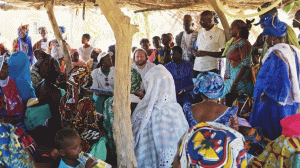This article has originally been published on Threebility, an open source platform for tools and games for sustainable product and business model innovation.
One of the reasons sustainability is often not taken seriously in business is that executives think“there is nothing we can do to address this issue”. In most cases, this is not true. In the digital health space, for example, few would think about sustainability. But taking sustainability seriously in the digital health space can not only contribute to the achievement of several UN sustainable development goals, it can also generate significant business upsides.
The rise of digital health care
Digital health solutions and health information technology are systematically transforming the way health care is delivered in the 21st century. Telemedicine and digital diagnostics solutions such as Kry, HealthTap, Ada or Gyant enable patients to receive remote and fast diagnostics in a more convenient way, electronic health records such as HealthSpek, Vivy and the TK App enable users to manage their health data and innovative smartphone applications provide patients with effective treatment, prevention or disease management solutions for conditions ranging from diabetes to depression.
Why should sustainability be an issue in healthcare? And why should we care?
But can digital health solutions also contribute to the implementation of the UN Sustainable Development Goals (SDGs)? To address this question, let’s look at 5 of the 17 SDGs:
- Goal 3: Ensure healthy lives and promote well-being for all at all ages
- Goal 5: Achieve gender equality and empower all women and girls
- Goal 10: Reduce inequality within and among countries
- Goal 12: Ensure sustainable consumption and production patterns
- Goal 13: Take urgent action to combat climate change and its impacts
The impact of DHS on SDG 3 is direct and obvious, and the primary purpose of DHS. This is not the case for SDGs 5, 10, 12 and 13, however. How should digital health solutions reduce inequality? And a connection between digital health and environmental sustainability may seem even more far-fetched. Nevertheless, making this connection is justified because it is already proven that digital solutions have the potential to create significant sustainability upsides in other industries, such as transportation, agriculture, manufacturing and energy.
Digital health is a particularly interesting area to consider, because some DHS are relevant for a large number of people and can achieve high market penetration. This is a luxury which solutions primarily centred around e.g. environmental sustainability rarely enjoy. If DHS would create sustainability benefits, these effects would therefore benefit from high market penetration and could potentially create large scale positive impact.
Sceptics may argue that it is difficult enough to transform the complex health care system, and that thinking about SDGs would only distract from that effort. But the SDGs are not intended to be a distraction. The Business and Sustainable Development Commission estimates that applying the SDGs to foster innovation and economic growth could generate $12 trillion each year in market opportunities and up to 380 million new jobs by 2030, and DHS offer the potential to explore new markets with high growth potential.
Furthermore, it has been shown that taking sustainability into account early during the design process of digital services can lead to the development of more innovative services and products. At the same time, the SDGs likely point to stricter upcoming regulation and new reporting standards, which can present substantial competitive advantages if acted upon pre-emptively by DHS providers. So it is far from certain that sustainability would be a cost creator, and instead might actually result in significant economic upsides.
Let’s now look at some of the areas where DHS may directly or indirectly help implement the SDGs 5, 10, 12 and 13.
1 - Reducing CO2 emissions and paper consumption through EHRs and telemedicine
Electronic health records (EHRs) enable patients to not only store digital versions of their health records, but also to request them from and exchange them with health care providers. Digital copies of patients health records could therefore substitute the use of paper, and make the use of paper based health records obsolete.
Based on an estimate by Kaiser Permanente, a US health insurer, the average outpatient paper based health record (chart) weighs 0,36kg, the average in patient chart weighs 0,62 kg, with 70% of the paper based records from outpatient care, and 30% from inpatient care. Replacing these records with EHRs, Kaiser Permanente calculated a savings potential of over 21.000 tons of CO2, which represents the amount of carbon sequestered by over 4.000 acres of fir or pine forest.
Telemedicine solutions and symptom checkers have the potential to reduce the need for ambulatory visits, and if visits take place, a patient equipped with a complete electronic health record will enjoy more productive visits, with better outcomes being able to be achieved with fewer visits, and less unnecessary double treatments. Telemedicine and EHR can result in a reduction of in-person visits by up to 26%, and the rate of ambulatory care visits by 7-11%. Replacing physical visits by telemedicine can result in a 40-70% reduction of carbon emissions. The savings potential due to reduced trips for Kaiser Permanente is estimated to be equivalent to up to the carbon sequestered by up to 19.200 acres of fir or pine forest.
The use of digital technologies does not come without cost, however. Unlike paper, which has a quasi fixed carbon footprint, a digital product requires devices and infrastructure (e.g. data centers) that consume energy and produce electronic waste. This negative impact therefore has to be taken into account.
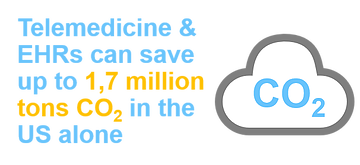
Balancing the potential positive benefits of EHR and Telemedicine solutions with the negative impact of the required energy usage and generated electronic waste, the maximum potential benefit of EHR and telemedicine based solutions in the US is estimated to be approximately 1,7 million tons of CO2 emissions saved. Whilst this only a represents a very small part of the overall contribution of the health care sector to greenhouse gas emissions (435 million metric tons annually), it is significant in the long run and the savings potential can be increased by following design principles summarised in section 3.
2 - Reducing inequalities between countries though the use of medical AI
Millions of people in developing countries struggle to access basic health care, and the WHO estimates that by 2030, almost 13 million additional skilled health professionals are needed worldwide. In developing countries, the shortage of skilled doctors and the lack of medical knowledge is particularly pronounced. DHS, particularly those enabled by AI, hold the promise to transform health-care in resource poor settings, address the skills and knowledge gap and and thereby to reduce the inequality of health care systems between countries.
Expert systems, e.g. symptom checkers such as Gyant and Ada, can provide expert level competence to patients and medical staff in developing countries, thereby contributing to the democratisation of medical knowledge and information. Such AI based expert systems not only improve the detection of medical conditions in developing countries, such as birth asphyxia, but can also be used to improve predictions of cholera outbreaks in Africa or dengue fever outbreaks in Asia. AI based planning solutions can be used to optimise the routes of community health workers to visit patients in remote areas separated by long distances, further improving efficiency.
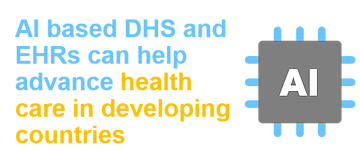
AI based solutions are particularly powerful if combined with Electronic Health Records (EHRs). OpenMRS for example is an open source EHR that is currently being used in more than 15 African countries. It was used in Kenya to improve maternal and child health and improve HIV treatment in rural areas, improving the completeness of collected data. When deployed in the cloud, EHRs hold the additional advantage that they can enable the implementation of applications relying on IT infrastructure in countries where such infrastructure does not yet exist. And when combined with natural language processing (NLP) capability, AI can be used to mine the EHR and the medical literature to provide expert treatment advice where no experts are present. This way, DHS offer the potential to “leap frog” health service technology in developing economies.
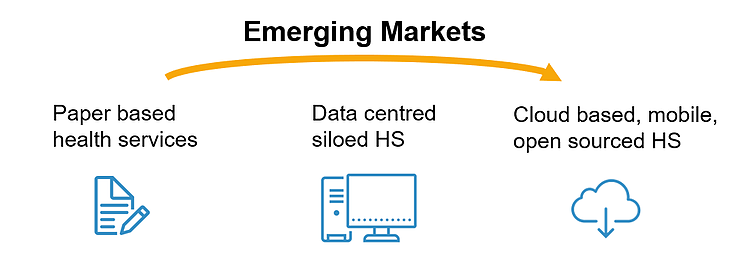
Whilst AI based solutions offer the potential to be "used for good", e.g. to reduce the cost of health care, to expand its coverage to remote areas and to increase medical expertise, their use does not come without challenges. Such solutions require high quality data sets, which can be difficult to collect, accurate tracking systems and high security standards regarding data privacy and protection. Due to the “black box” character of many AI solutions, it is often difficult to assess them for biases that might actually increase, rather than decrease, inequalities. One of several ideas to address some of these challenges is to open source medical AI solutions and DHS, as is the case of Open MRS, Hippo AI and the Open AI initiative.
3 - Empowerment of women and reducing child mortality
Digital health apps for women are becoming increasingly popular, and often show very high engagement from their users. Solutions such as Eve, Clue or What to expect, even though still not perfect, have the potential to help women preventing pregnancies, preparing and planning for conceiving a child or ensuring a healthy pregnancy.
Due to the easy accessibility as smartphone apps, comparative affordability and ability to convey health information in a digestible format, these Femtech DHS have to potential to empower women with low incomes and women in developing economies, where health services are underdeveloped and healthcare is not affordable to everyone.
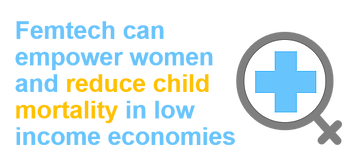
For example, the non-profit Text4Baby has reached more than half a million women with yearly incomes of less than $16.000. Maya, an app enabling women to track their menstrual and general health, aims to increase its presence in India, where menstrual health is still often considered a taboo.
In Tanzania, an NGO has developed a mobile phone based tool that assists community care workers to deliver targeted information to pregnant women, and in Kenya, the Bill and Melinda Gates Foundation funded the successful use of mobile phone SMS reminders to increase the rates of immunisation of children. These solutions not only empower women to take their reproductive health into their own hands, but may also reduce the child mortality in low and middle income countries, which is also an important step towards more sustainable birth rates. Whilst Femtech solutions still face many challenges related to the difficulty to accurately personalise the results, privacy, trust and information overwhelm, their use is rapidly gaining traction in the developing world.
4 - The digital nudge – behaviour change benefiting health and environment
Apps promoting behaviour change represent another digital health solution which could potentially generate positive environmental benefits. For example, apps like Weight Watchers or Lifesum help users to adopt and stick to more healthy diets. And these apps are not only popular amongst users, but also effective. In randomised trials, the use of smartphone apps has been associated with improved dietary compliance for healthier, lower calorie, low fat, and high fiber foods which resulted in more weight loss for patients. A majority of app users agreed that using their diet and nutrition apps increased their motivation to eat healthy and led to changes in their behaviour.

This is interesting because behaviour change centred around diet is a good example of a strong correlation of healthier living with more environmentally friendly living. The average calorie consumption, and particularly the average protein consumption exceeds the recommended value in all developed and now also in the majority of developing economies, with the meat-based protein consumption even exceeding the total recommended protein consumption in the EU and the US. Excessive meat consumption in particular has been shown to increase the risk of cancer (particularly in case of processed meat), heart disease, obesity and even food poisoning.
At the same time, the environmental impact of meat-based diets is significantly worse than that of plant-based diets along the three dimensions greenhouse gas emissions, land use and freshwater consumption, with beef being the worst of all meat based proteins.
The impact of this smart-phone app induced dietary change could be significant. The average US diet (2009) required nearly a hectare of farmable land and resulted in 1,4 tons of CO2 equivalent. Merely the reduction of a single meat type, beef, can reduce per person land use and greenhouse gas emissions by 15 – 35%, whilst more ambitious diet changes can result in reductions of over 50%.
Digital health solutions based behaviour change can of course be used to promote further dietary habits that also correlate with positive environmental impact, such as the reduction of the consumption of sugary drinks which reduces risks of diabetes and the creations of waste in form of cans and plastic bottles.
Even the promotion of mental wellbeing by apps such as Headspace, Moodpath and 7Mind can indirectly contribute to environmental sustainability, as a mental wellbeing is arguably a requirement for the ability of humans to be able to a) change behaviour in the first place and b) extend their concerns beyond the self to broader society.
How to make the most of the sustainability potential of DHS
Contributing to the achievement of the SDGs may not be very high on the agenda of the typical executive in the digital health space. But by regarding the potential sustainability benefits of digital health solutions as a “nice to have”, we are not only wasting an opportunity to make a positive impact in the world, but also an opportunity to create the positive business upsides.
For this reason, it is important that leaders, designers and strategists in the digital health space weave the SDGs into their long term business strategies and take the sustainability aspect seriously, following a triple bottom line approach. This also means to take sustainability into account from the beginning of the design process, where the positive impact can be maximised. This is best achieved by exploring the adaptability of DHS strategies for emerging markets and developing countries, by correlating positive health outcomes with positive environmental outcomes, and by applying values based intelligent design principles. The following guidelines can help to achieve this goal.
Invest in emerging markets and adapt DHS to local needs
Technological innovation often strives where the needs are greatest, or where sufficient “imperfections” exist. This is why mobile payment solutions such as M-Pesa developed and prosper in in emerging economies. For DHS professionals thinking about internationalisation, it may be tempting to look at the usual suspects USA and Europe only, but this could be a mistake. Emerging markets not only offer the opportunity to make a significant contribution to achieving the SDGs, particularly SDGs 3, 5 and 10, but they will also play a major role in the future of digital health.
This is because specific solutions such as EHRs and telemedicine are uniquely suited to address the health needs of developing countries where more than 50% of the population still lives in rural areas. At the same time, the healthcare demands of many developing countries are growing, as are their middle class, aging population and and average incomes. In addition, many chronic diseases such as diabetes are no longer “rich country” diseases but become increasingly frequent in developing countries. Finally The high penetration of mobile devices in developing countries can facilitate rapid uptake of DHS. The necessary infrastructure for smartphone based DHS solutions is also in place: many developing countries already have more than 90% 2G and more than 80% 3G coverage.
To make the most of this potential, DHS providers should focus on the following key DHS technologies:
- Telemedicine to improve the access to care of DHS
- EHR technologies to improve the care continuum
- DHS to improve the effectiveness and efficiency of health workers
- AI enabled DHS to improve medical decision making
- Femtech solutions to enable women to better control their reproductive health
At the same time, DHS for emerging markets need to be adapted to both the local health system and the local consumer preferences. Whilst there are still many challenges that come with an expansion into emerging market, the opportunities may outweigh the risks in many cases.
Optimise for Digitisation & Substitution
For an EHR to generate the intended paper-substitution effects, rebound-effects such resulting from paperless environments, where some patients may print out more paper copies of their EHR than they would normally receive, need to be avoided. Therefore, access, transferability and readability of the digital copies need to be optimised. This can be achieved for example by enabling web-based desktop usage of EHR apps and by driving the integration and document exchange functionality of EHRs with hospitals, doctors, payors and pharmacies. The integration with hospitals in particular is important here, as hospitals are a major producer of paper-based health-records.
As for the ability of telemedicine solutions to substitute actual doctor visits with virtual telemedicine consultations, and thus save transportation costs: here the incentives of payors to minimise health-care costs are in most cases already aligned with the environmental benefits. However, the environmental benefits of telemedicine solutions can be increased if the adoption of telemedicine solutions can be accelerated, the number of relevant use cases increased and extended to broader audiences.
At the same time, it is important to ensure that an integration of EHR and telemedicine solutions with existing digital infrastructure minimises the need for additional IT infrastructure and the generation of electronic waste.
Optimise for behaviour change
The generally applicable best practices to apply effective digital nudges in smart-phone applications to promote behaviour change typically include providing clear instructions, providing feedback on performance, goal setting and planning for social support. Promoting diet shifts is particularly difficult, however, as tracking of consumed calories and therefore data-based feedback on performance can be difficult to achieve. However, EHRs may offer an opportunity for improvement, as a broader range of health-data can be correlated with diet, such as the biological age, and therefore create stronger incentives. To achieve the best results, the following strategies can be applied:
- Minimise the required change in consumer habits, for example by providing concrete suggestions or recipes for substitute diets similar in taste, look, texture, smell.
- Emphasize and correlate compelling benefits of the new diet related to health and costs
- Increase awareness through one to one correlation of specific health values with specific diets, for which EHRs are particularly well suited
The path ahead
This article discussed only a fraction of the potential of DHS to support the implementation of the UN SDGs. Being aware of this potential is the first step towards its maximisation. After all, our health and the health of our planet are inseparably connected, and a truly progressive approach to digital health product development has to take an integral view on the topic of sustainability. This is the essence of the triple bottom line approach, where economic, ecological and social aspects are all taken into account in order to design a truly desirable future.
#ICTforgreen #DigitalHealth #sustainableinnovation
****
Dr. Robert Gerlach is the founder of Threebility. Robert has a long-standing interest in the intersection of technology and sustainability and over 15 years of professional experience in startups, management consulting and R&D. He currently lives and works in Berlin.









